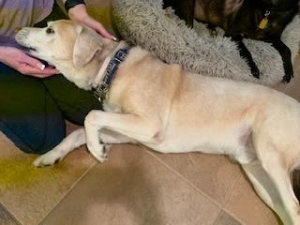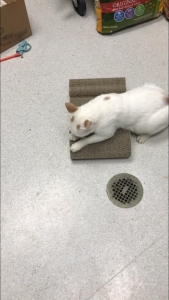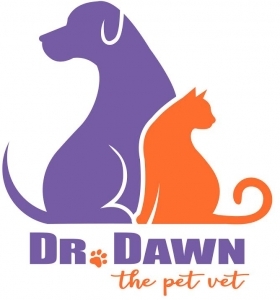Friends and clients have been asking me for decades what the disturbing gagging/choking noise coming from their dog is. You all have seen it I am sure. If not, go to You Tube and check out any number of hundreds of videos of it.  It looks like your puppy is choking on something, gasping for breath. It is probably one of the most common questions I get, and is definitely the most common activity I see reenacted by clients. Many wonder if they caused it, or if it is innocuous. Most want to know how to prevent it. Hopefully this will clear up many of those FAQs.
It looks like your puppy is choking on something, gasping for breath. It is probably one of the most common questions I get, and is definitely the most common activity I see reenacted by clients. Many wonder if they caused it, or if it is innocuous. Most want to know how to prevent it. Hopefully this will clear up many of those FAQs.
Reverse sneezing is actually a Pharyngeal Gag Reflex, and is a disconcerting event to witness. The unpleasant respiratory sounds a dog makes during these episodes sound like your dog may be dying. It sounds similar to the honking sound a dog makes with a collapsing trachea. But, reverse sneezing is a far simpler condition that usually does not need any medical treatment. It sounds a bit like a dog inhaling sneezes; hence the name.
The most common cause is an irritation of the soft palate and throat that results in a spasm. During the spasm, the dog’s neck will extend and the chest will expand as the dog tries harder to inhale. The underlying problem is that the trachea has narrowed at this point, making it hard to get the normal amount of air into the lungs.
Anything that irritates the throat can cause this spasm and subsequent sneeze. Those causes may include excitement, eating or drinking, exercise intolerance, pulling on a leash, mites in the nasal cavity, pollen, foreign bodies caught in the throat, perfumes, viruses, household chemicals, allergies, and post-nasal drip. If an irritant in the home is the cause, taking your dog outside can help because he will no longer be inhaling the irritant. If it happens often when your dog is leashed, and particularly if he pulls a lot on the leash, switch to a harness that does not put pressure on the neck.
Brachycephalic dogs (those with flat faces, such as Pugs and Boxers) with elongated soft palates occasionally suck the elongated palate into the throat while inhaling, causing reverse sneezing. Small dogs are particularly prone to it, possibly because they have smaller diameter throats, and therefore, tracheas.
Reverse sneezing itself rarely requires treatment. If the sneezing stops, the spasm is over. Often, you can massage the dog’s throat during an episode, in an attempt to stop the spasm. Sometimes, covering the nostrils will help, because it will cause the dog to swallow, and thereby clear out whatever the irritation is and stops the sneezing. But, if the episode doesn’t end quickly, you can try depressing the dog’s tongue, which opens up the mouth and aids in moving air through the nasal passages.
Less commonly, there are underlying medical causes, and treating them will decrease the likelihood of recurrence. This is in the case of dogs that have many episodes, in short periods of time, or is becoming a chronic problem, rather than an occasional occurrence.
Mites can inhabit the laryngeal area. This is more common a condition in certain parts of the country than others, such as the South. Still, if this problem is persistent, your veterinarian can scope the area to check for their presence and treat them if necessary. Allergies also may be at the root of the problem. Many times, a trial of antihistamines may help the condition, and simultaneously arm you with a weapon for when this occurs, while helping you and your vet diagnose allergies if they were not noted before. Still, in many cases, no cause can be identified.
Because reverse sneezing is not a severe problem, do not worry about leaving your dog home alone. Episodes most likely end on their own, whether or not you are present. Some dogs have these episodes their entire lives, and some will develop the condition only as they age. Many dogs, as they age, are more likely to have their trachea collapse, an thus are more prone to it when older. But remember, in most dogs, the spasm is a temporary problem that goes away on its own, leaving the dog with no after-effects.

Cats are less likely to reverse sneeze than dogs are. However, owners should always have the veterinarian examine their cat in case it is feline asthma, which requires more treatment than reverse sneezing does.

Hopefully this will put your mind at ease, the next time it happens.
Dr. Dawn
Please share and subscribe here





